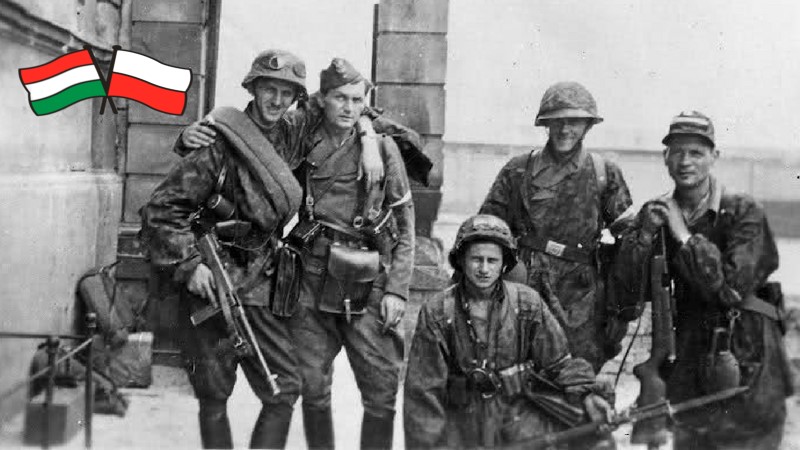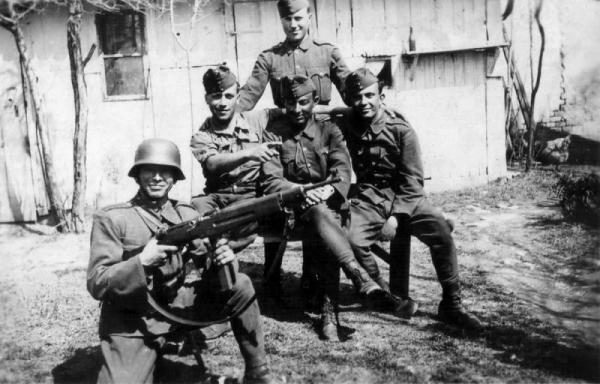
Of the many brotherly pages in Polish-Hungarian relations, one of the brightest is the attitude of the Hungarian army during the heroic 63 days of fighting in Warsaw in 1944. Warsaw and Poles still remember today how their brothers in arms behaved then.
Hungary was dragged into the Third Reich's system of military alliances during World War II. The Hungarian army fought on the eastern front, incurring considerable losses. It was stationed in numerous countries occupied by Germany. However, Hungarian soldiers never took up arms against any Polish armed formation, nor did they treat Poland as an occupied country. Reports from the various locations where the Hungarian troops were stationed on their way to and from the front since 1943 are generally very good. Hungarian officers were able to inform the soldiers properly that they were not in a hostile country, that they should maintain discipline and respect for the Polish population. German intelligence was well aware of the moods prevailing among Hungarian soldiers stationed in Poland, and received reports of secret handover of equipment and even weapons to Polish underground formations, mainly the Home Army. The Wehrmacht command was aware of the difficulties associated with the attempt to use the Hungarian army to take action against the Poles, but in 1944 it no longer had much room for manoeuvre. There was a shortage of military units, and those regiments and divisions, which German command had at its disposal, were almost always short of men.

In July 1944, the front was approaching Warsaw and the Germans were also moving units towards Warsaw, which could be used to secure operations in the area of this important transport junction.
Major General Béla Lengyel was appointed the commander of the Second Hungarian Corps, operating in the Warsaw region. His name ominously means… a Pole. According to family legend, it was to come from Polish nobles named Zajączkowski, who changed their name after escaping persecution to Hungary. It is not known whether it is true, but it is a fact that the general held the position of military attaché in Warsaw for several years. The corps consisted of three infantry divisions with incomplete units and a cavalry division, also without a full staff. There were shortages in terms of heavy equipment and artillery, the corps could not cope with frontline assignments associated with defending against the offensive of the Red Army, but it could be used for secondary tasks.
Right from the outset, Warsaw insurgents, who set off to fight on August 1, 1944, counted very much on the forests surrounding the capital city. The Kampinos Forest, Kabackie Forests, Chojnowskie Forests were a place where partisan troops were concentrated, an area of weapons and supplies airdrops. It was from these areas that help came for the fighting capital. The German command tried to close the routes of communication from Warsaw to the forests near Warsaw, but it lacked combat units as these were still involved in heavy fighting with the insurgents. Nicolaus von Vormann, the commander of the German 9th Army, knew perfectly well that the Hungarian army could not be forced to shoot at Poles in any way. He only had hope that they would at least serve as a passive barrier hindering contact between Polish troops. This hope has turned out to be illusory.
The 12th Infantry Division was directed to the Kampinos Forest to cut off the largest forest complex north of Warsaw. In all Polish records, the best memories of the mutual contacts between the units have been preserved. The forest was a place where airdrops with help for the Uprising were dropped, here large partisan units also gathered. The movements between the forest and Żoliborz took place mainly at night, but there was no combat with the Hungarian units. On many occasions officers from both sides determined march routes in advance in order to avoid any incidents or accidental shooting. The 1st Cavalry Division, operating south of Warsaw, acted in a similar way.
The commander of the German 9th Army was well aware of the attitude of the Hungarian troops when preparing the report:
“In the western part of the Kampinos Forest, fresh forces for the Warsaw rebels came from the reserves of national militias. To rout them up and prevent them from getting to Warsaw, special forces were required. Attention should be paid to the Hungarian troops stationed here, whose irresponsible attitude poses a threat to the heavy defensive combat we are engaged in.”
Many accounts survive about the transfer of military hardware, supplies and even weapons for the insurgents by the Hungarian troops. The Hungarians also passed on information about the movements of the German army against the Polish positions. At one point, the command of the 9th German Army issued an order to shoot Hungarian soldiers captured "in the act" of helping Poles. Their graves are scattered around Warsaw, among others in the forests near the Zalesie Górne. The Hungarians also helped civilians, who were driven out in various ways of the districts of Warsaw occupied by the Germans. Over time, Hungarian troops began to withdraw from the region and move to Hungary. This was caused by two issues: the total lack of trust of the German command, obvious cases of helping Polish insurgents and the withdrawal of Romania from the coalition of states allied with the Third Reich. Hungarian Honvéds were needed more urgently in their homeland.

An interesting and still not fully researched Hungarian motif in the Warsaw Uprising is the participation of Hungarians in fighting on the Polish side. On August 5th, the legendary Home Army battalion "Zośka" captured the "Gęsiowka" German concentration camp, liberating several hundred Jewish. Hungarian Jews were also among them. A certain number of these joined the liberators, eagerly taking on staff duty (doctors, cooks) or rear-guard duty. Unfortunately, they shared the fate of one of the best formations of the Uprising and this also meant very high losses in the subsequent stages of the fighting.
The Warsaw Uprising ended after 63 days of very heavy fighting. Those who survived were taken prisoner by the Germans or had to go into exile. The participants of these dramatic days remembered the very good attitude of Hungarians towards the residents of the capital city.
In 2015, a book by Maria Zima "Węgrzy wobec Powstania Warszawskiego" ("Hungarians in the Face of the Warsaw Uprising") was published, discussing in detail the mutual relations in the difficult days of the Uprising. The book is also available to Hungarian readers in their native language.
Every year on 1 August at 5 p.m. the entire city stops for a minute, the streets are full of smoke, white and red flags can be seen everywhere. On this day, young Warsaw residents recall the memories of their grandparents and great-grandparents about the year 1944. The Hungarians have a warm place in these memories.
Warsaw remembers,
Honour and Glory to the Heroes!
Marcin Bąk
